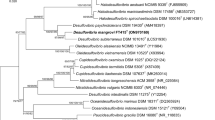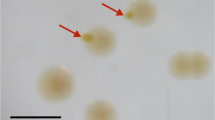Abstract
Diphenylarsinic acid (DPAA) is often found as a toxic intermediate metabolite of diphenylchloroarsine or diphenylcyanoarsine that were produced as chemical warfare agents and were buried in soil after the World Wars. In our previous study Guan et al. (J Hazard Mater 241–242:355–362, 2012), after application of sulfate and carbon sources, anaerobic transformation of DPAA in soil was enhanced with the production of diphenylthioarsinic acid (DPTAA) as a main metabolite. This study aimed to isolate and characterize anaerobic soil microorganisms responsible for the metabolism of DPAA. First, we obtained four microbial consortia capable of transforming DPAA to DPTAA at a high transformation rate of more than 80 % after 4 weeks of incubation. Sequencing for the bacterial 16S rRNA gene clone libraries constructed from the consortia revealed that all the positive consortia contained Desulfotomaculum acetoxidans species. In contrast, the absence of dissimilatory sulfite reductase gene (dsrAB) which is unique to sulfate-reducing bacteria was confirmed in the negative consortia showing no DPAA reduction. Finally, strain DEA14 showing transformation of DPAA to DPTAA was isolated from one of the positive consortia. The isolate was assigned to D. acetoxidans based on the partial 16S rDNA sequence analysis. Thionation of DPAA was also carried out in a pure culture of a known sulfate-reducing bacterial strain, Desulfovibrio aerotolerans JCM 12613T. These facts indicate that sulfate-reducing bacteria are microorganisms responsible for the transformation of DPAA to DPTAA under anaerobic conditions.




Similar content being viewed by others
References
Arao T, Maejima Y, Baba K (2009) Uptake of aromatic arsenicals from soil contaminated with diphenylarsinic acid by rice. Environ Sci Technol 43:1097–1101
Baba K, Arao T, Maejima Y, Watanabe E, Eun H, Ishizaka M (2008) Arsenic speciation in rice and soil containing related compounds of chemical warfare agents. Anal Chem 80:5768–5775
Bausinger T, Preuß J (2005) Environmental remnants of the First World War: soil contamination of a burning ground for arsenical ammunition. B Environ Contam Tox 74:1045–1052
Buddhawong S, Kuschk P, Mattusch J, Wiessner A, Stottmeister U (2005) Removal of arsenic and zinc using different laboratory model wetland systems. Eng Life Sci 5:247–252
Daus B, Hempel M, Wennrich R, Weiss H (2010) Concentrations and speciation of arsenic in groundwater polluted by warfare agents. Environ Pollut 158:3439–3444
Duncan WFA, Mattes AG, Gould WD, Goodazi F (2004) Multi-stage biological treatment system for removal of heavy metal contaminants. In: Rao SR, Harrison FW, Kosinski JA, Amaratunga LM, Cheng TC, Richards GG (eds) The fifth international symposium on waste processing and recycling in mineral and metallurgical industries. Canadian Institute of Mining, Metallurgy and Petroleum, Hamilton, pp 469–483
Garnaga G, Wyse E, Azemard S, Stankevičius A, de Mora S (2006) Arsenic in sediments from the southeastern Baltic Sea. Environ Pollut 144:855–861
Groudev S, Georgiev P, Spasova I, Nicolova M (2008) Bioremediation of acid mine drainage in a uranium deposit. Hydrometallurgy 94:93–99
Guan L, Hisatomi S, Fujii K, Nonaka M, Harada N (2012) Enhanced transformation of diphenylarsinic acid in soil under sulfate-reducing conditions. J Hazard Mater 241–242:355–362
Haas R, Schmidt TC, Steinbach K, von Löw E (1998) Chromatographic determination of phenylarsenic compounds. Fresenius J Anal Chem 361:313–318
Hanaoka S, Nagasawa E, Nomura K, Yamazawa M, Ishizaki M (2005) Determination of diphenylarsenic compounds related to abandoned chemical warfare agents in environmental samples. Appl Organomet Chem 19:265–275
Harada N, Takagi K, Baba K, Fujii K, Iwasaki A (2010) Biodegradation of diphenylarsinic acid to arsenic acid by novel soil bacteria isolated from contaminated soil. Biodegradation 21:491–499
Hisatomi S, Guan L, Fujii K, Nonaka M, Harada N (2013) Formation of diphenylthioarsinic acid from diphenylarsinic acid under anaerobic sulfate-reducing soil conditions. J Hazard Mater 262:25–30
Ishii K, Tamaoka A, Otsuka F, Iwasaki N, Shin K, Matsui A, Endo G, Kumagai Y, Ishii T, Shoji S, Ogata T, Ishizaki M, Doi M, Shimojo N (2004) Diphenylarsinic acid poisoning from chemical weapons in Kamisu, Japan. Ann Neurol 56:741–745
Ishizaki M, Yanaoka T, Nakamura M, Hakuta T, Ueno S, Komuro M, Shibata M, Kitamura T, Honda A, Doy M, Ishii K, Tamaoka A, Shimojo N, Ogata T, Nagasawa E, Hanaoka S (2005) Detection of bis(diphenylarsine)oxide, diphenylarsinic acid and phenylarsonic acid, compounds probably derived from chemical warfare agents, in drinking well water. J Health Sci 51:130–137
Köhler M, Hofmann K, Völsgen F, Thurow K, Koch A (2001) Bacterial release of arsenic ions and organoarsenic compounds from soil contaminated by chemical warfare agents. Chemosphere 43:425–429
Li Y, Low GKC, Scott JA, Amal R (2011) Microbial transformation of arsenic species in municipal landfill leachate. J Hazard Mater 188:140–147
Maejima Y, Arao T, Baba K (2011) Transformation of diphenylarsinic acid in agricultural soils. J Environ Qual 40:76–82
Mogensen GL, Kjeldsen KU, Ingvorsen K (2005) Desulfovibrio aerotolerans sp. nov., an oxygen tolerant sulphate-reducing bacterium isolated from activated sludge. Anaerobe 11:339–349
Nakamiya K, Nakayama T, Ito H, Edmonds JS, Shibata Y, Morita M (2007) Degradation of arylarsenic compounds by microorganisms. FEMS Microbiol Lett 274:184–188
Newman DK, Beveridge TJ, Morel FMM (1997) Precipitation of arsenic trisulfide by Desulfotomaculum auripigmentum. Appl Environ Microb 63:2022–2028
Scholten JCM, Stams AJM (2000) Isolation and characterization of acetate-utilizing anaerobes from a freshwater sediment. Microb Ecol 40:292–299
Sierra-Alvarez R, Yenal U, Field JA, Kopplin M, Gandolfi AJ, Garbarino JR (2006) Anaerobic biotransformation of organoarsenical pesticides monomethylarsonic acid and dimethylarsinic acid. J Agr Food Chem 54:3959–3966
Singhakant C, Koottatep T, Satayavivad J (2009) Enhanced arsenic removals through plant interactions in subsurface-flow constructed wetlands. J Environ Sci Heal A 44:163–169
Song JH, Jeon CO, Choi MH, Yoon SC, Park W (2008) Polyhydroxyalkanoate (PHA) production using waste vegetable oil by Pseudomonas sp. strain DR2. J Microbiol Biotechn 18:1408–1415
Spring S, Lapidus A, Schröder M, Gleim D, Sims D, Meincke L, Glavina Del Rio T, Tice H, Copeland A, Cheng JF, Lucas S, Chen F, Nolan M, Bruce D, Goodwin L, Pitluck S, Ivanova N, Mavromatis K, Mikhailova N, Pati A, Chen A, Palaniappan K, Land M, Hauser L, Chang YJ, Jeffries CD, Chain P, Saunders E, Brettin T, Detter JC, Göker M, Bristow J, Eisen JA, Markowitz V, Hugenholtz P, Kyrpides NC, Klenk HP, Han C (2009) Complete genome sequence of Desulfotomaculum acetoxidans type strain (5575). Stand Genomic Sci 1:242–253
Stackebrandt E, Sproer C, Rainey FA, Burghardt J, Päuker O, Hippe H (1997) Phylogenetic analysis of the genus Desulfotomaculum: evidence for the misclassification of Desulfotomaculum guttoideum and description of Desulfotomaculum orientis as Desulfosporosinus orientis gen. nov., comb. nov. Int J Syst Evol Micr 47:1134–1139
Taylor BF, Oremland RS (1979) Depletion of adenosine triphosphate in Desulfovibrio by oxyanions of group VI elements. Curr Microbiol 3:101–103
Wada T, Nagasawa E, Hanaoka S (2006) Simultaneous determination of degradation products related to chemical warfare agents by high-performance liquid chromatography/mass spectrometry. Appl Organomet Chem 20:573–579
Wanger M, Roger AJ, Flax JL, Brusseau GA, Stahl DA (1998) Phylogeny of dissimilatory sulfite reductases supports an early origin of sulfate respiration. J Bacteriol 180:2975–2982
Weisburg WG, Barns SM, Pelletier DA, Lane DJ (1991) 16S ribosomal DNA amplification for phylogenetic study. J Bacteriol 173:697–703
Widdel F, Pfennig N (1977) A new anaerobic, sporing, acetate-oxidizing, sulfate-reducing bacterium, Desulfotomaculum (emend.) acetoxidans. Arch Microbiol 112:119–122
Widdel F, Pfennig N (1981) Sporulation and further nutritional characteristics of Desulfotomaculum acetoxidans. Arch Microbiol 129:401–402
Woolson EA (1975) Bioaccumulation of arsenicals. In: Woolson EA (ed) Arsenical pesticides, pp 97–107
Yamazaki K, Fujii K, Iwasaki A, Takagi K, Satsuma K, Harada N, Uchimura T (2008) Different substrate specificities of two triazine hydrolases (TrzNs) from Nocardioides species. FEMS Microbiol Lett 286:171–177
Acknowledgments
This research was financed in part by the Grants-in-Aid for Scientific Research (No. 22510083 and 25340084) from the Japan Society for the Promotion of Science and the Iijima Memorial Foundation for the Promotion of Food Science and Technology. We thank the Field Center for Sustainable Agriculture and Forestry, Faculty of Agriculture, Niigata University, for providing soil samples.
Author information
Authors and Affiliations
Corresponding author
Rights and permissions
About this article
Cite this article
Guan, L., Shiiya, A., Hisatomi, S. et al. Sulfate-reducing bacteria mediate thionation of diphenylarsinic acid under anaerobic conditions. Biodegradation 26, 29–38 (2015). https://doi.org/10.1007/s10532-014-9713-2
Received:
Accepted:
Published:
Issue Date:
DOI: https://doi.org/10.1007/s10532-014-9713-2




